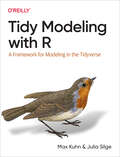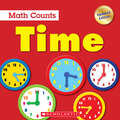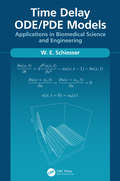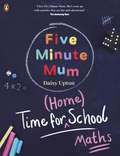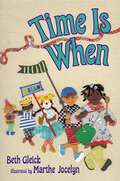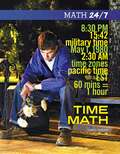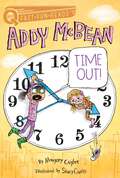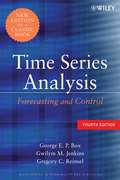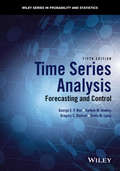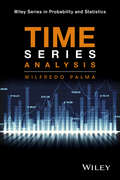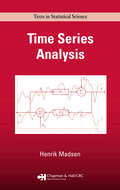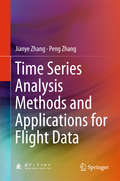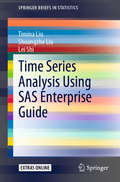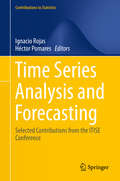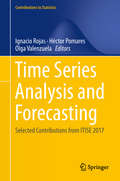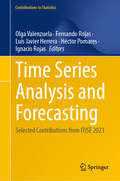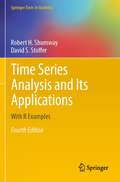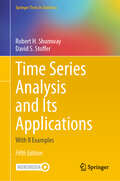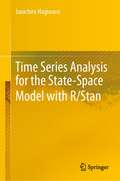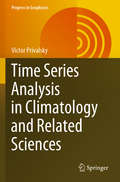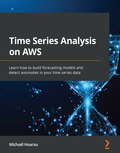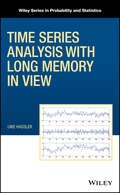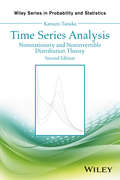- Table View
- List View
Tidy Modeling with R: A Framework for Modeling in the Tidyverse
by Max Kuhn Julia SilgeGet going with tidymodels, a collection of R packages for modeling and machine learning. Whether you're just starting out or have years of experience with modeling, this practical introduction shows data analysts, business analysts, and data scientists how the tidymodels framework offers a consistent, flexible approach for your work.RStudio engineers Max Kuhn and Julia Silge demonstrate ways to create models by focusing on an R dialect called the tidyverse. Software that adopts tidyverse principles shares both a high-level design philosophy and low-level grammar and data structures, so learning one piece of the ecosystem makes it easier to learn the next. You'll understand why the tidymodels framework has been built to be used by a broad range of people.With this book, you will:Learn the steps necessary to build a model from beginning to endUnderstand how to use different modeling and feature engineering approaches fluentlyExamine the options for avoiding common pitfalls of modeling, such as overfittingLearn practical methods to prepare your data for modelingTune models for optimal performanceUse good statistical practices to compare, evaluate, and choose among models
Time (Math Counts: Updated Editions #6)
by Henry PluckroseAn introduction to capacity for the youngest readers!Math Counts series introduces young readers (grades K-3) to early math concepts. Real-world examples and corresponding photos make math concepts easy to grasp.Time is a measure of the hours, days, months, and years we live through.
Time Delay ODE/PDE Models: Applications in Biomedical Science and Engineering
by W.E. SchiesserTime delayed (lagged) variables are an inherent feature of biological/physiological systems. For example, infection from a disease may at first be asymptomatic, and only after a delay is the infection apparent so that treatment can begin.Thus, to adequately describe physiological systems, time delays are frequently required and must be included in the equations of mathematical models. The intent of this book is to present a methodology for the formulation and computer implementation of mathematical models based on time delay ordinary differential equations (DODEs) and partial differential equations (DPDEs). The DODE/DPDE methodology is presented through a series of example applications, particularly in biomedical science and engineering (BMSE). The computer-based implementation of the example models is explained with routines coded (programmed) in R, a quality, open-source scientific computing system that is readily available from the Internet. Formal mathematics isminimized, e.g., no theorems and proofs. Rather, the presentation is through detailed examples that the reader/researcher/analyst can execute on modest computers. The DPDE analysis is based on the method of lines (MOL), an established general algorithm for PDEs, implemented with finite differences. The example applications can first be executed to confirm the reported solutions, then extended by variation of the parameters and the equation terms, and even the forumulation and use of alternative DODE/DPDE models. • Introduces time delay ordinary and partial differential equations (DODE/DPDEs) and their numerical computer-based integration (solution) • Illustrates the computer implementation of DODE/DPDE models with coding (programming) in R, a quality, open-source scientific programming system readily available from the Internet • Applies DODE/DPDE models to biological/physiological systems through a series of examples • Provides the R routines for all of the illustrative applications through a download link • Facilitates the use of the models with reasonable time and effort on modest computers
Time Dependent Phase Space Filters: A Stable Absorbing Boundary Condition (SpringerBriefs on PDEs and Data Science)
by Minh-Binh Tran Avy Soffer Chris StucchioThis book introduces an interesting and alternative way to design absorbing boundary conditions (ABCs) for quantum wave equations, basically the nonlinear Schrödinger equation. The focus of this book is the application of the phase space filter approach to derive accurate radiation conditions for Schrödinger equations.Researchers who are interested in partial differential equations and mathematical physics might find this book appealing.
Time For Home School: Five minute fun games and activities to support early years and KS1 children with number sentences, counting and times tables
by Daisy UptonAn exclusive first look at Five Minute Mum: Time for School with the Maths chapter. It may not clear all those home school headaches, but it will make life easier- and a bit more fun too! The Maths chapter from Five Minute Mum: Time for School, is packed full of fun activities to immediately help support your child's maths learning including learning your number bonds, timetables and everything in between. Time for Home School: Maths is THE book you need if you're home-schooling, from former teaching assistant, bestselling author and social media superstar Daisy Upton AKA Five Minute Mum. This short chapter is all based around the maths your child will be taught in their first few years at school - Early Years, Reception and Key Stage 1 - will bring some much-needed laughter to your at-home learning and, if nothing else, give you five minutes where you feel like you are getting it right.Remember: 'IF YOU ARE TRYING, YOU ARE BRILLIANT' Daisy Upton brings her unique five-minute, learning-through-play method to these quick and easy, fun games and activities that are all maths based, using stuff you probably already have at home. Maths is taken from Five Minute Mum: Time for School- the ultimate handbook to support your child through Early Years, Reception and KS1 - available from 15 April 2021. Praise for Five Minute Mum: Give Me Five: 'I love Five Minute Mum. She's managed to come up with a huge array of activities for kids that are fun and educational yet don't require an Art degree or Diploma in Patience to execute. Her blog makes these kinds of games accessible to everyone and for that, I am grateful! - Sarah Turner, Unmumsy Mum 'So many fab ideas in here! Love it' - Rosie Ramsey
Time Is When
by Beth GleickWhat is time? This question, asked nearly fifty years ago by author Beth Gleick’s young son, prompted her to answer in a picture book for preschoolers, using simple language and familiar scenes: “In one second, you can bounce a ball, or jump, or say hello, or turn a page.”Beth Gleick’s clean turn of phrase cleverly explains the passing of seconds, minutes, hours, on up through seasons and years. First published in 1960, this book is lovingly re-illustrated by collage-artist Marthe Jocelyn, who pays homage to the original art while simultaneously creating a world of her own, cutting patterned papers and printed fabrics with whimsy, ingenuity, and precision of, yes, time. . . .
Time Math (Math 24/7)
by James FischerWe live our lives according to the numbers on a clock. Whether it's getting to school on time, allowing enough time in a day for the things we need to do, or timing an activity, those numbers are an important part of almost everything we do. Time Math will help you understand schedules and timetables. You'll be able to better manage the math that runs our clocks!
Time Out!: A QUIX Book (Addy McBean #2)
by Margery CuylerA second-grade math whiz tackles telling time in this second book in the Addy McBean series—part of the Aladdin QUIX line!Addy McBean, a second grader at PS #8, is up to her eyebrows (two) in myriad (lots) of adventures. She&’s never met a number she hasn&’t liked! Lately, she&’s found a lot to love in clocks, watches, and anything that tells time. But on their class trip, will Addy and her friends find themselves in time out?
Time Series Analysis
by Gregory C. Reinsel George E. Box Gwilym M. JenkinsA modernized new edition of one of the most trusted books on time series analysis. Since publication of the first edition in 1970, Time Series Analysis has served as one of the most influential and prominent works on the subject. This new edition maintains its balanced presentation of the tools for modeling and analyzing time series and also introduces the latest developments that have occurred n the field over the past decade through applications from areas such as business, finance, and engineering.The Fourth Edition provides a clearly written exploration of the key methods for building, classifying, testing, and analyzing stochastic models for time series as well as their use in five important areas of application: forecasting; determining the transfer function of a system; modeling the effects of intervention events; developing multivariate dynamic models; and designing simple control schemes. Along with these classical uses, modern topics are introduced through the book's new features, which include:A new chapter on multivariate time series analysis, including a discussion of the challenge that arise with their modeling and an outline of the necessary analytical toolsNew coverage of forecasting in the design of feedback and feedforward control schemesA new chapter on nonlinear and long memory models, which explores additional models for application such as heteroscedastic time series, nonlinear time series models, and models for long memory processesCoverage of structural component models for the modeling, forecasting, and seasonal adjustment of time seriesA review of the maximum likelihood estimation for ARMA models with missing valuesNumerous illustrations and detailed appendices supplement the book,while extensive references and discussion questions at the end of each chapter facilitate an in-depth understanding of both time-tested and modern concepts. With its focus on practical, rather than heavily mathematical, techniques, Time Series Analysis, Fourth Edition is the upper-undergraduate and graduate levels. this book is also an invaluable reference for applied statisticians, engineers, and financial analysts.
Time Series Analysis
by Gregory C. Reinsel George E. Box Gwilym M. Jenkins Greta M. LjungPraise for the Fourth Edition "The book follows faithfully the style of the original edition. The approach is heavily motivated by real-world time series, and by developing a complete approach to model building, estimation, forecasting and control." - Mathematical Reviews Bridging classical models and modern topics, the Fifth Edition of Time Series Analysis: Forecasting and Control maintains a balanced presentation of the tools for modeling and analyzing time series. Also describing the latest developments that have occurred in the field over the past decade through applications from areas such as business, finance, and engineering, the Fifth Edition continues to serve as one of the most influential and prominent works on the subject. Time Series Analysis: Forecasting and Control, Fifth Edition provides a clearly written exploration of the key methods for building, classifying, testing, and analyzing stochastic models for time series and describes their use in five important areas of application: forecasting; determining the transfer function of a system; modeling the effects of intervention events; developing multivariate dynamic models; and designing simple control schemes. Along with these classical uses, the new edition covers modern topics with new features that include: A redesigned chapter on multivariate time series analysis with an expanded treatment of Vector Autoregressive, or VAR models, along with a discussion of the analytical tools needed for modeling vector time series An expanded chapter on special topics covering unit root testing, time-varying volatility models such as ARCH and GARCH, nonlinear time series models, and long memory models Numerous examples drawn from finance, economics, engineering, and other related fields The use of the publicly available R software for graphical illustrations and numerical calculations along with scripts that demonstrate the use of R for model building and forecasting Updates to literature references throughout and new end-of-chapter exercises Streamlined chapter introductions and revisions that update and enhance the exposition Time Series Analysis: Forecasting and Control, Fifth Edition is a valuable real-world reference for researchers and practitioners in time series analysis, econometrics, finance, and related fields. The book is also an excellent textbook for beginning graduate-level courses in advanced statistics, mathematics, economics, finance, engineering, and physics.
Time Series Analysis
by Wilfredo PalmaTime Series is the result of more than 20 years of teaching courses at both the upper-undergraduate and beginning-graduate levels. The main motivation is to provide a broad coverage of the most fundamental aspects of time series analysis and its applications at an introductory level. As a consequence, the text focuses only on the treatment of univariate time series, covering a number of well-known models such as ARMA and ARIMA. The text also provides an updated coverage of several useful and newly-developed techniques such as weak and strong dependence, Bayesian methods, non-Gaussian data, and local stationarity, missing values and outliers, threshold models, among others. The topics are systematically organized in a progressive manner so as to provide suitable continuity from beginning to end. Examples, exercise sets, and their corresponding solutions are plentiful. Theory is discussed when relevant. Every effort is made to make the book self-contained. A companion Web site is available for readers to access the R data sets used within the text.
Time Series Analysis (Chapman & Hall/CRC Texts in Statistical Science)
by Henrik MadsenWith a focus on analyzing and modeling linear dynamic systems using statistical methods, Time Series Analysis formulates various linear models, discusses their theoretical characteristics, and explores the connections among stochastic dynamic models. Emphasizing the time domain description, the author presents theorems to highlight the most
Time Series Analysis Methods and Applications for Flight Data
by Peng Zhang Jianye ZhangThis book focuses on different facets of flight data analysis, including the basic goals, methods, and implementation techniques. As mass flight data possesses the typical characteristics of time series, the time series analysis methods and their application for flight data have been illustrated from several aspects, such as data filtering, data extension, feature optimization, similarity search, trend monitoring, fault diagnosis, and parameter prediction, etc. An intelligent information-processing platform for flight data has been established to assist in aircraft condition monitoring, training evaluation and scientific maintenance. The book will serve as a reference resource for people working in aviation management and maintenance, as well as researchers and engineers in the fields of data analysis and data mining.
Time Series Analysis Using SAS Enterprise Guide (SpringerBriefs in Statistics)
by Timina Liu Shuangzhe Liu Lei ShiThis is the first book to present time series analysis using the SAS Enterprise Guide software. It includes some starting background and theory to various time series analysis techniques, and demonstrates the data analysis process and the final results via step-by-step extensive illustrations of the SAS Enterprise Guide software. This book is a practical guide to time series analyses in SAS Enterprise Guide, and is valuable resource that benefits a wide variety of sectors.
Time Series Analysis and Forecasting
by Ignacio Rojas Héctor PomaresThis volume presents selected peer-reviewed contributions from The International Work-Conference on Time Series, ITISE 2015, held in Granada, Spain, July 1-3, 2015. It discusses topics in time series analysis and forecasting, advanced methods and online learning in time series, high-dimensional and complex/big data time series as well as forecasting in real problems. The International Work-Conferences on Time Series (ITISE) provide a forum for scientists, engineers, educators and students to discuss the latest ideas and implementations in the foundations, theory, models and applications in the field of time series analysis and forecasting. It focuses on interdisciplinary and multidisciplinary research encompassing the disciplines of computer science, mathematics, statistics and econometrics.
Time Series Analysis and Forecasting: Selected Contributions From The Itise Conference (Contributions To Statistics Ser. #0)
by Ignacio Rojas Héctor Pomares Olga ValenzuelaThis book presents selected peer-reviewed contributions from the International Work-Conference on Time Series, ITISE 2017, held in Granada, Spain, September 18-20, 2017. It discusses topics in time series analysis and forecasting, including advanced mathematical methodology, computational intelligence methods for time series, dimensionality reduction and similarity measures, econometric models, energy time series forecasting, forecasting in real problems, online learning in time series as well as high-dimensional and complex/big data time series.The series of ITISE conferences provides a forum for scientists, engineers, educators and students to discuss the latest ideas and implementations in the foundations, theory, models and applications in the field of time series analysis and forecasting. It focuses on interdisciplinary and multidisciplinary research encompassing computer science, mathematics, statistics and econometrics.
Time Series Analysis and Forecasting: Selected Contributions from ITISE 2023 (Contributions to Statistics)
by Ignacio Rojas Héctor Pomares Olga Valenzuela Fernando Rojas Luis Javier HerreraThis volume on the latest developments in the theory and applications of time series analysis and forecasting comprises a selection of refereed papers presented at the 9th International Conference on Time Series and Forecasting, ITISE 2023, held in Gran Canaria, Spain, July 12-14, 2023. It is divided into several parts that address modern theoretical aspects of time series analysis, advanced econometric methods, time series and machine learning, financial forecasting and risk analysis, and applications to various disciplines, including econometrics and energy research. The broad range of topics and applications presented, including matters of particular relevance for sustainable development, gives readers a modern perspective on the subject. The ITISE conference series provides a forum for scientists, engineers, educators and students to discuss the latest advances and implementations in the foundations, theory, models and applications of time series analysis and forecasting. It focuses on interdisciplinary research encompassing computer science, mathematics, statistics and econometrics.
Time Series Analysis and Its Applications: With R Examples (Springer Texts in Statistics)
by Robert H. Shumway David S. StofferThe fourth edition of this popular graduate textbook, like its predecessors, presents a balanced and comprehensive treatment of both time and frequency domain methods with accompanying theory. Numerous examples using nontrivial data illustrate solutions to problems such as discovering natural and anthropogenic climate change, evaluating pain perception experiments using functional magnetic resonance imaging, and monitoring a nuclear test ban treaty.The book is designed as a textbook for graduate level students in the physical, biological, and social sciences and as a graduate level text in statistics. Some parts may also serve as an undergraduate introductory course. Theory and methodology are separated to allow presentations on different levels. In addition to coverage of classical methods of time series regression, ARIMA models, spectral analysis and state-space models, the text includes modern developments including categorical time series analysis, multivariate spectral methods, long memory series, nonlinear models, resampling techniques, GARCH models, ARMAX models, stochastic volatility, wavelets, and Markov chain Monte Carlo integration methods.This edition includes R code for each numerical example in addition to Appendix R, which provides a reference for the data sets and R scripts used in the text in addition to a tutorial on basic R commands and R time series. An additional file is available on the book’s website for download, making all the data sets and scripts easy to load into R.
Time Series Analysis and Its Applications: With R Examples (Springer Texts in Statistics)
by Robert H. Shumway David S. StofferThis 5th edition of this popular graduate textbook presents a balanced and comprehensive treatment of both time and frequency domain methods with accompanying theory. It includes numerous examples using nontrivial data illustrate solutions to problems such as discovering natural and anthropogenic climate change, evaluating pain perception experiments using functional magnetic resonance imaging, and monitoring a nuclear test ban treaty. The R package ‘astsa’ has had major updates and the text will reflect those updates. In general, the graphics have been improved. New topics include random number generation, modeling and fitting predator-prey interactions, more emphasis on structural models, testing for linearity, discussion of EM algorithm is more extensive, Bayesian analysis of state space models and MCMC is more extensive (including new scripts in astsa), particle methods are introduced, stochastic volatility coverage is expanded, changepoint detection is introduced (new topic). The book is designed as a textbook for graduate level students in the physical, biological, and social sciences and as a graduate level text in statistics. Some parts may also serve as an undergraduate introductory course. Theory and methodology are separated to allow presentations on different levels. In addition to coverage of classical methods of time series regression, ARIMA models, spectral analysis and state-space models, the text includes modern developments including categorical time series analysis, multivariate spectral methods, long memory series, nonlinear models, resampling techniques, GARCH models, ARMAX models, stochastic volatility, and Markov chain Monte Carlo integration methods. This edition includes R code for each numerical example.
Time Series Analysis for the Social Sciences
by Janet M. Box-steffensmeier John R. Freeman Matthew P. Hitt Jon C. W. PevehouseTime series, or longitudinal, data are ubiquitous in the social sciences. Unfortunately, analysts often treat the time series properties of their data as a nuisance rather than a substantively meaningful dynamic process to be modeled and interpreted. Time Series Analysis for the Social Sciences provides accessible, up-to-date instruction and examples of the core methods in time series econometrics. Janet M. Box-Steffensmeier, John R. Freeman, Jon C. Pevehouse and Matthew P. Hitt cover a wide range of topics including ARIMA models, time series regression, unit-root diagnosis, vector autoregressive models, error-correction models, intervention models, fractional integration, ARCH models, structural breaks, and forecasting. This book is aimed at researchers and graduate students who have taken at least one course in multivariate regression. Examples are drawn from several areas of social science, including political behavior, elections, international conflict, criminology, and comparative political economy.
Time Series Analysis for the State-Space Model with R/Stan
by Junichiro HagiwaraThis book provides a comprehensive and concrete illustration of time series analysis focusing on the state-space model, which has recently attracted increasing attention in a broad range of fields. The major feature of the book lies in its consistent Bayesian treatment regarding whole combinations of batch and sequential solutions for linear Gaussian and general state-space models: MCMC and Kalman/particle filter. The reader is given insight on flexible modeling in modern time series analysis. The main topics of the book deal with the state-space model, covering extensively, from introductory and exploratory methods to the latest advanced topics such as real-time structural change detection. Additionally, a practical exercise using R/Stan based on real data promotes understanding and enhances the reader’s analytical capability.
Time Series Analysis in Climatology and Related Sciences (Progress in Geophysics)
by Victor PrivalskyThis book gives the reader the basic knowledge of the theory of random processes necessary for applying to study climatic time series. It contains many examples in different areas of time series analysis such as autoregressive modelling and spectral analysis, linear extrapolation, simulation, causality, relations between scalar components of multivariate time series, and reconstructions of climate data. As an important feature, the book contains many practical examples and recommendations about how to deal and how not to deal with applied problems of time series analysis in climatology or any other science where the time series are short.
Time Series Analysis on AWS: Learn how to build forecasting models and detect anomalies in your time series data
by Michael HoarauLeverage AWS AI/ML managed services to generate value from your time series dataKey FeaturesSolve modern time series analysis problems such as forecasting and anomaly detectionGain a solid understanding of AWS AI/ML managed services and apply them to your business problemsExplore different algorithms to build applications that leverage time series dataBook DescriptionBeing a business analyst and data scientist, you have to use many algorithms and approaches to prepare, process, and build ML-based applications by leveraging time series data, but you face common problems, such as not knowing which algorithm to choose or how to combine and interpret them. Amazon Web Services (AWS) provides numerous services to help you build applications fueled by artificial intelligence (AI) capabilities. This book helps you get to grips with three AWS AI/ML-managed services to enable you to deliver your desired business outcomes.The book begins with Amazon Forecast, where you'll discover how to use time series forecasting, leveraging sophisticated statistical and machine learning algorithms to deliver business outcomes accurately. You'll then learn to use Amazon Lookout for Equipment to build multivariate time series anomaly detection models geared toward industrial equipment and understand how it provides valuable insights to reinforce teams focused on predictive maintenance and predictive quality use cases. In the last chapters, you'll explore Amazon Lookout for Metrics, and automatically detect and diagnose outliers in your business and operational data.By the end of this AWS book, you'll have understood how to use the three AWS AI services effectively to perform time series analysis.What you will learnUnderstand how time series data differs from other types of dataExplore the key challenges that can be solved using time series dataForecast future values of business metrics using Amazon ForecastDetect anomalies and deliver forewarnings using Lookout for EquipmentDetect anomalies in business metrics using Amazon Lookout for MetricsVisualize your predictions to reduce the time to extract insightsWho this book is forIf you're a data analyst, business analyst, or data scientist looking to analyze time series data effectively for solving business problems, this is the book for you. Basic statistics knowledge is assumed, but no machine learning knowledge is necessary. Prior experience with time series data and how it relates to various business problems will help you get the most out of this book. This guide will also help machine learning practitioners find new ways to leverage their skills to build effective time series-based applications.
Time Series Analysis with Long Memory in View (Wiley Series in Probability and Statistics #215)
by Uwe HasslerProvides a simple exposition of the basic time series material, and insights into underlying technical aspects and methods of proof Long memory time series are characterized by a strong dependence between distant events. This book introduces readers to the theory and foundations of univariate time series analysis with a focus on long memory and fractional integration, which are embedded into the general framework. It presents the general theory of time series, including some issues that are not treated in other books on time series, such as ergodicity, persistence versus memory, asymptotic properties of the periodogram, and Whittle estimation. Further chapters address the general functional central limit theory, parametric and semiparametric estimation of the long memory parameter, and locally optimal tests. Intuitive and easy to read, Time Series Analysis with Long Memory in View offers chapters that cover: Stationary Processes; Moving Averages and Linear Processes; Frequency Domain Analysis; Differencing and Integration; Fractionally Integrated Processes; Sample Means; Parametric Estimators; Semiparametric Estimators; and Testing. It also discusses further topics. This book: Offers beginning-of-chapter examples as well as end-of-chapter technical arguments and proofs Contains many new results on long memory processes which have not appeared in previous and existing textbooks Takes a basic mathematics (Calculus) approach to the topic of time series analysis with long memory Contains 25 illustrative figures as well as lists of notations and acronyms Time Series Analysis with Long Memory in View is an ideal text for first year PhD students, researchers, and practitioners in statistics, econometrics, and any application area that uses time series over a long period. It would also benefit researchers, undergraduates, and practitioners in those areas who require a rigorous introduction to time series analysis.
Time Series Analysis: Nonstationary and Noninvertible Distribution Theory
by Katsuto TanakaReflects the developments and new directions in the field since the publication of the first successful edition and contains a complete set of problems and solutions This revised and expanded edition reflects the developments and new directions in the field since the publication of the first edition. In particular, sections on nonstationary panel data analysis and a discussion on the distinction between deterministic and stochastic trends have been added. Three new chapters on long-memory discrete-time and continuous-time processes have also been created, whereas some chapters have been merged and some sections deleted. The first eleven chapters of the first edition have been compressed into ten chapters, with a chapter on nonstationary panel added and located under Part I: Analysis of Non-fractional Time Series. Chapters 12 to 14 have been newly written under Part II: Analysis of Fractional Time Series. Chapter 12 discusses the basic theory of long-memory processes by introducing ARFIMA models and the fractional Brownian motion (fBm). Chapter 13 is concerned with the computation of distributions of quadratic functionals of the fBm and its ratio. Next, Chapter 14 introduces the fractional Ornstein–Uhlenbeck process, on which the statistical inference is discussed. Finally, Chapter 15 gives a complete set of solutions to problems posed at the end of most sections. This new edition features: • Sections to discuss nonstationary panel data analysis, the problem of differentiating between deterministic and stochastic trends, and nonstationary processes of local deviations from a unit root • Consideration of the maximum likelihood estimator of the drift parameter, as well as asymptotics as the sampling span increases • Discussions on not only nonstationary but also noninvertible time series from a theoretical viewpoint • New topics such as the computation of limiting local powers of panel unit root tests, the derivation of the fractional unit root distribution, and unit root tests under the fBm error Time Series Analysis: Nonstationary and Noninvertible Distribution Theory, Second Edition, is a reference for graduate students in econometrics or time series analysis. Katsuto Tanaka, PhD, is a professor in the Faculty of Economics at Gakushuin University and was previously a professor at Hitotsubashi University. He is a recipient of the Tjalling C. Koopmans Econometric Theory Prize (1996), the Japan Statistical Society Prize (1998), and the Econometric Theory Award (1999). Aside from the first edition of Time Series Analysis (Wiley, 1996), Dr. Tanaka had published five econometrics and statistics books in Japanese.
